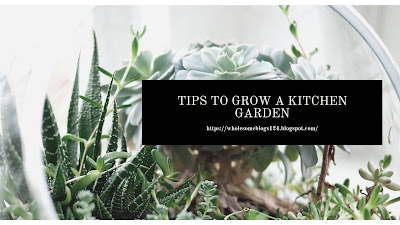Tips to grow a Kitchen Garden | Guide |
Tips to grow a Kitchen Garden | Guide |

Start a kitchen garden by taking cuttings from some of your favorite plants indoors and outdoors and rooting them in water. Use plums or a sharp knife to cut a 3- or 4-inch stem; unfold the lower leaves and place the cut stem in a small container with water. If you want, choose colorful containers and set them on a windowsill for a pretty nice effect.
Although not suitable for every plant, rooting houseplants in water is the easiest method of propagation. Change the water in containers weekly, as the black water becomes cloudy and distracts the attractiveness of the arrangement. More importantly, bacteria can grow and create an unhealthy environment for kitchen plants.
Enjoy the cuttings in the winter months, then transplant them into containers and place them outdoors for the summer.
What you need to know about transplantation

Most plants for a kitchen garden succeed only for a limited time, without soil in which to spread their roots. When transplanting rooted cuttings into pot mix, remember that the roots they form in the water are finer and more fragile than the ones they grow in the soil. At least a week after transplanting, keep the pot mixture moist to avoid shocking the kitchen plants and allow the chances of new roots to grow. However, cuttings that are rooted in the soil should be watered once they are placed in a soil pot to begin to grow, and not again until the soil is almost dry.
The garden with plants

Start with the right container
If you choose a houseplant that is too small, your herbs will not like it. Too big and will not fit on a windowsill. Find a kitchen plant plant about 4 inches deep and how wide your sill will allow. Lots of cute and smart plantations of kitchen plants can dress up your kitchen. (Be careful: glazed ones can prevent evaporation, leading to soul roots.) Consider painting terracotta potted plants with chalk paint, then write the plant names on the sides. Another trick: add stakes to know what is what. If you're rebuilding something else - say a vintage tin - make sure it has a drain hole and a plate to catch excess water. It is a necessity.

Then add herbs
Most herbs are super easy to get started. You can cut a branch from an outside plant and stick it in the potted soil. You can buy seeds - although you will have to wait longer for the finished herbs. Or you can buy small seedlings.
Gardening Tip: You can purchase an indoor garden kit to help you get started!

Stir in a little sun
Outside, you need to carefully consider whether the kitchen plants like the sun or shade. Inside, with herbs, all you need is a happy and healthy dose of sunshine from a windowsill (facing south is best). Look for a place with about six hours of good rays for your garden with indoor wall plants. You will also need a soil-free pot mix, and you may need to fertilize every other month.
Kitchen vegetable garden
Vegetables require at least six hours of sunshine daily
You will need a few sunny windows or artificial lighting for your vegetable garden to do the trick.
Make decorative arrangements
Combine different indoor plants in one container. Plant red and green leaf salad together, for example, or border a container holding a terrace tomato with leaf and radish salad.
Fertilize vegetables every two weeks
Water to keep the soil moist, especially when the vegetables in the indoor garden begin to bloom and bear fruit. Help fruit production by lightly brushing vegetables in the kitchen garden by hand to spread pollen as they bloom.
Grow these garden vegetables indoors:
Beans
Bush tomatoes
carrot
Cherry tomatoes
cucumbers
Free leaf salad
Patio tomatoes
green peas
Polished grains
scallions
Spinach
More wonderful plants for your little garden:
Angelwing Begonia
Hoya
Swedish Ivy
The Wandering Jew (Tradescantia)
Purple passion plant
coleus
Gardenia
Air plants





Comments
Post a Comment